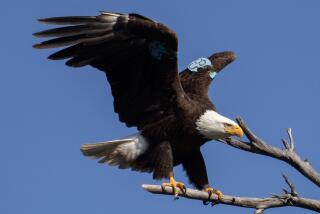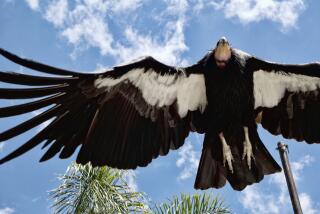Female Condor Knows It Takes Two to Tango
San Diego’s condor love story is hardly a one-sided affair, the San Diego Wild Animal Park has discovered.
As keepers at the park closely monitor the pair that produced the first captive-bred condor egg, on March 3, they confirmed during the past week that the female also is initiating the courtship dance that is more commonly observed in the male.
This is the first time such behavior by the female has been confirmed in California condors, said Tom Hanscom, spokesman for the park.
“It had been observed in the wild, but, because the birds were not tagged, it was hard to be sure it was the female,” Hanscom said.
First, Neck Nibbling
To initiate mating, the male goes through an elaborate courtship ritual. First he nibbles at the female’s face and neck, then he spreads his wings and marches back and forth. When the female approaches, he curves his spread wings inward. Swaying this feather cape back and forth, he almost envelops the female. She ducks her head to signal she is ready.
On Wednesday, a video camera captured the female, called UN1, doing an abbreviated version of the courtship ritual, Hanscom said.
“She does basically the same thing. She doesn’t do it as intricately, but the same basic approach. And when she has gotten his interest, then she drops her wings and he responds” by mounting her, Hanscom said.
Don Sterner, lead condor keeper, called the finding interesting but not critical. “It’s certainly not something that’s going to save the species, but it’s noteworthy behavior,” he said.
Waiting for an Egg
Sterner and other keepers of the 14 condors at the park have been especially watchful of UN1 and her mate, AC4, during the past week because UN1 could lay a second egg at any time. It takes about 30 days after an egg is laid for the female to become fertile again, Hanscom said.
The egg could be produced at any time between last week and mid-May, he said.
“We’re waiting for a change in behavior that we observed before--that is, where the female suddenly starts staying close to the nest box,” Sterner said. “When we see that, then we’ll be certain that something’s going to happen within the next couple of days.”
The egg laid March 3 is due to hatch in late April. The embryo appears to be developing normally, Sterner added.
“By this time it has little feet and wings, a heartbeat,” he said. “Basically, it’s just getting larger, it’s just growing. It’s at the shape it’s going to be. It’s just going to get bigger and bigger in the shell.”
The park’s 14 condors and the 13 at the Los Angeles Zoo are the only known survivors of a species that was decimated over the past century, largely because of pesticides and lead poisoning. A joint federal-state condor recovery project aims to breed the animals in captivity and then begin reintroducing them to the wild, possibly as early as 1993.
More to Read
Sign up for Essential California
The most important California stories and recommendations in your inbox every morning.
You may occasionally receive promotional content from the Los Angeles Times.










